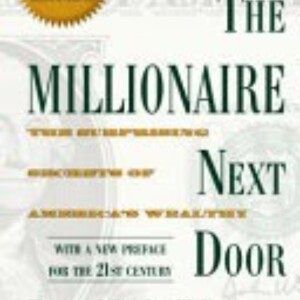

"The Millionaire Next Door: The Surprising Secrets of America's Wealthy" is a book written by Thomas J. Stanley and William D. Danko, first published in 1996. The authors conducted extensive research on the habits, behaviors, and demographics of wealthy individuals in the United States, particularly focusing on how they accumulate and maintain their wealth.
Author's Background
- Thomas J. Stanley: He was a researcher and author who specialized in the study of American affluence and wealth accumulation. Stanley held a Ph.D. in business administration and was known for his meticulous research methodology. His work focused on the psychology, behavior, and practices of the affluent, often contrasting the visible lifestyles of the rich with the underlying financial practices that truly build wealth.
- William D. Danko: Danko was a professor of marketing and a researcher who collaborated with Stanley on multiple projects related to personal finance and entrepreneurship. His expertise complemented Stanley's, allowing them to create a comprehensive analysis of wealthy Americans.
Book's Context
- Research and Methodology: The authors conducted surveys and interviews with numerous millionaires, emphasizing self-made individuals rather than those who inherited wealth. They aimed to uncover the philosophical and practical approaches to wealth accumulation. Their findings highlighted striking differences between millionaires and the general populace, shedding light on attitudes towards spending, saving, and investment.
- Surprising Findings: "The Millionaire Next Door" revealed that many wealthy individuals live modestly, often in middle-class neighborhoods, drive older vehicles, and prioritize savings over conspicuous consumption. The authors distinguished between "prodigious accumulators of wealth," who save and invest aggressively, and "under-accumulators of wealth," who live beyond their means.
- Cultural and Economic Context: The book emerged during the 1990s, a period characterized by economic growth and rising consumerism in the United States. This socio-economic backdrop set the stage for a better understanding of financial behaviors and attitudes toward wealth. The authors’ message resonated with readers as it provided a counter-narrative to the prevalent notion that wealth equated to lavish spending and a high-profile lifestyle.
- Impact: "The Millionaire Next Door" became a bestseller and significantly influenced personal finance literature. It has encouraged readers to adopt more frugal lifestyles, prioritize saving, and be mindful of their financial habits. The book is often cited in discussions about wealth-building strategies and financial independence.
In summary, "The Millionaire Next Door" serves as a pivotal analysis of the behavioral traits of wealth accumulation, challenging common stereotypes about wealth and offering practical guidance for attaining financial success. The authors’ backgrounds as researchers provided a rigorous foundation for their findings, making the book both insightful and practical for readers seeking to improve their financial well-being.
Chapter 2 Analysis of main characters and plot"The Millionaire Next Door" by Thomas J. Stanley and William D. Danko is a non-fiction book that explores the habits and characteristics of wealthy individuals in America. Rather than focusing on extravagant lifestyles, it reveals that many millionaires are ordinary people living frugally and mindfully. Here are key concepts and relevant "characters" that guide the book's insights:
Key Characters/Profiles:
- The Millionaire:
- Represents individuals who have accumulated wealth through hard work, discipline, and smart financial decisions. They often live in modest homes and drive older cars.
- Characteristics include self-discipline, financial planning, and a preference for saving over spending.
- The Under-Accumulated Wealthy (UAW):
- Individuals who appear wealthy but do not have significant net worth. They often spend excessively to maintain an image of wealth and success.
- Characteristics include consumerism, living beyond means, and reliance on credit.
Main Plot Clues/Development:
- Frugality:
- True millionaires prioritize saving and investing over conspicuous consumption. They often eschew luxury goods and lifestyles.
- Financial Education:
- Many millionaires are educated about finances and make informed decisions regarding investments and savings. They tend to be lifelong learners.
- Entrepreneurship:
- A significant portion of millionaires are self-employed or own businesses. Their entrepreneurial spirit contributes to their wealth accumulation.
- Budgeting and Planning:
- Wealthy individuals often live by strict budgets, planning their expenses and savings carefully to build wealth over time.
- Family Influence:
- Millionaires often pass down values of frugality and hard work to their children, emphasizing the importance of earning and saving.
- Community and Networking:
- Many affluent individuals engage in their communities and maintain relationships with like-minded peers, which supports their financial habits and growth.
Conclusion:
The primary message of "The Millionaire Next Door" is that wealth is often hidden beneath simplicity. By highlighting the contrasting lifestyles of true millionaires and those who are merely appearing wealthy, the book emphasizes the importance of financial discipline, education, and community in building true wealth. Readers can learn practical lessons to apply in their own financial lives.
Chapter 3 Theme Exploration and Analysis"The Millionaire Next Door: The Surprising Secrets of America's Wealthy" by Thomas J. Stanley and William D. Danko explores several key themes and topics that offer insights into the behaviors and mindsets of wealthy individuals in America. Here’s a deep dive into some of the most significant themes:
- Frugality and Value Consciousness
One of the primary themes of the book is the frugal lifestyle that many millionaires lead. Contrary to the stereotype of wealthy individuals living in opulence, the authors find that many millionaires live below their means. They prioritize value over status, often opting for practical purchases rather than luxury items. This emphasis on frugality enables them to accumulate wealth.
- Investment in Wealth-Building Assets
Stanley and Danko highlight that self-made millionaires typically invest in wealth-building assets rather than extravagant consumer goods. They focus on assets like real estate, stocks, and businesses that can generate income and appreciate over time. This contrasts with individuals who prioritize spending on luxury items, which do not contribute to wealth accumulation.
- Economic Independence vs. High Income
The distinction between being wealthy and simply having a high income is a critical topic. The authors argue that many high-income earners do not accumulate wealth because they tend to spend disproportionately. In contrast, many millionaires may not have exceptionally high incomes but achieve economic independence through smart financial choices and disciplined saving.
- Financial Planning and Management
The book emphasizes the importance of meticulous financial planning. Successful millionaires often set clear financial goals, develop budgets, and make informed decisions about their spending and investing. Financial literacy plays a crucial role in their wealth-building journey, allowing them to navigate complex financial landscapes.
- Self-Discipline and Hard Work
Self-discipline and a strong work ethic are portrayed as essential characteristics of millionaires. The authors note that many wealthy individuals work hard and are dedicated to their professions or businesses. They often pursue lifelong learning and skill development to enhance their earning potential.
- Family and Upbringing
The role of family upbringing in cultivating a millionaire mindset is another important theme. The authors explore how values regarding money, work, and education are often instilled from a young age. Families that emphasize frugal living and financial responsibility tend to produce children who grow into financially independent adults.
- Networking and Relationships
Networking is another theme discussed in the book, focusing on the importance of building and maintaining relationships that can contribute to business opportunities and learning. Wealthy individuals often surround themselves with like-minded people who provide support and share similar financial philosophies.
- Risk Tolerance
The authors identify a balanced approach to risk as a trait of many millionaires. While they recognize the necessity of taking calculated risks in investing or starting a business, they also maintain a conservative mindset regarding financial management. This dual approach helps them to grow their wealth steadily while avoiding unnecessary pitfalls.
- Avoiding Social Pressure
Many millionaires resist social pressures to keep up appearances, which can lead to financial distress. The ability to ignore societal expectations regarding material possessions allows them to focus on saving and investing rather than conforming to consumerist trends.
- Different Types of Millionaires
Stanley and Danko categorize millionaires into different groups based on their wealth sources, such as "producers" (self-employed, business owners) and "accumulators" (those who save diligently). Understanding these categories helps clarify the diverse paths to wealth.
Conclusion
"The Millionaire Next Door" provides readers with a compelling look at the habits, values, and practices that define America's wealthy individuals. It challenges common assumptions about wealth and success, promoting a mindset centered around frugality, disciplined saving and investing, and the importance of education and hard work. By examining these themes, the authors provide valuable lessons that can apply to anyone aspiring to improve their financial situation.
Here are ten notable quotes from "The Millionaire Next Door" by Thomas J. Stanley and William D. Danko:
- "Wealth is more often the result of hard work, careful planning, and intelligence than it is of fortunate circumstances."
- "The affluent don’t spend money they don’t have."
- "Many millionaires are made, not born."
- "Frugality is a cornerstone of wealth building."
- "The true measure of a successful person is not how much they earn, but how much they save and invest."
- "The majority of millionaires are self-made."
- "Most wealthy individuals are not flashy; they prefer to blend in with their surroundings."
- "Income is not the same as wealth; many people who earn a high income are actually poor."
- "Living below your means is a fundamental principle of wealth accumulation."
- "The most successful people are often those who are able to save and invest consistently over time."
These insights from the book emphasize the importance of discipline, frugality, and strategic financial planning when it comes to building wealth.
Book https://www.bookey.app/book/the-millionaire-next-door
Author https://www.bookey.app/book/the-millionaire-next-door#Author
Quotes https://www.bookey.app/book/the-millionaire-next-door/quote
Suggested
Youtube https://www.youtube.com/watch?v=Wb1YAJv_LCM
Amazon https://www.amazon.com/Millionaire-Next-Door-Surprising-Americas/dp/1589795474
Goodreads https://www.goodreads.com/book/show/998.The_Millionaire_Next_Door
More Episodes
All Episodes>>Create Your Podcast In Minutes
- Full-featured podcast site
- Unlimited storage and bandwidth
- Comprehensive podcast stats
- Distribute to Apple Podcasts, Spotify, and more
- Make money with your podcast












